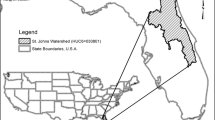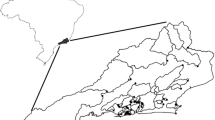Abstract
A landscape-level approach was applied to eight rural watersheds to assess the role that wetlands play in reducing phosphorus loading to surface waters in the Lake Champlain Basin. Variables summarizing various characteristics of wetlands within a watershed were calculated using a geographic information system and then compared to measured phosphorus loading through multiple regression analyses. The inclusion of a variable based on the area of riparian wetlands located along low- and medium-order streams in conjunction with the area of agricultural and nonwetland forested lands explained 88% of the variance in phosphorus loading to surface waters. The best fit model coefficients (Pload = 0.86Ag + 0.64For − 30Ripwet + 160) suggest that a hectare of riparian wetland may be many times more important in reducing phosphorus than an agricultural hectare is in producing phosphorus. These results provide additional support for the concept that protection of riparian wetlands is an important management strategy for controlling stream water quality in multiuse landscapes.
Similar content being viewed by others
Literature Cited
Anderson, J. R., E. E. Hardy, J. T. Roach, and R. E. Whitmer. 1976. A land use and land cover classification system for use with remote sensor data. US Geological Survey Professional Paper 964. US Geological Survey, Washington, DC.
Brinson, M. M. 1988. Strategies for assessing the cumulative effects of wetland alteration on water quality.Environmental Management 12(5):655–662.
Budd, L. F., and D. W. Meals. 1994. Lake Champlain nonpoint source pollution assessment. Technical report No. 6, Lake Champlain Basin Program. Gordon-Center House, 54 West Shore Road, Grand Isle, Vermont 05458.
Chambers, J. M., T. J. Wrigley, and A. J. McComb. 1993. The potential use of wetlands to reduce phosphorus export from agricultural catchments.Fertilizer Research 36:157–164.
Clausen, J. C., and G. D. Johnson. 1990. Lake level influences on sediment and nutrient retention in a lakeside wetland.Journal of Environmental Quality 19:83–88.
Detenbeck, N. E., C. A. Johnson, and G. J. Niemi. 1993. Wetland effects on lake water quality in the Minneapolis/St. Paul metropolitan area.Landscape Ecology 8(1):39–61.
Frink, C. R. 1991. Estimating nutrient exports to estuaries.Journal of Environmental Quality 20:717–724.
Gehrels, J., and G. Mulamoottil. 1989. The transformation and export of phosphorus from wetlands.Hydrological Processes 3:365–370.
Gilliam, J. W. 1994. Riparian wetlands and water quality.Journal of Environmental Quality 23:896–900.
Gilliland, M. W., and W. Baxter-Potter. 1987. A geographical information system to predict nonpoint source pollution potential.Water Resources Bulletin 23(2):281–291.
Howard-Williams, C. 1985. Cycling and retention of nitrogen and phosphorus in wetlands: A theoretical and applied perspective.Freshwater Biology 15:391–431.
Johnston, C. A., N. E. Detenbeck, and G. J. Niemi. 1990. The cumulative effect of wetlands on stream water quality and quantity. A landscape approach.Biogeochemistry 10:105–141.
Masscheleyn, P. H., J. H. Pardue, R. D. DeLaune, and W. H. Patrick. 1992. Phosphorus release and assimilatory capacity of two lower Mississippi Valley freshwater wetland soils.Water Resources Bulletin 28(4):763–773.
Mitsch, W. J. 1992. Combining ecosystem and landscape approaches to Great Lakes wetlands.Journal of Great Lakes Research 18(4):552–570.
Mitsch, W. J. and B. C. Reeder. 1991. Modeling nutrient retention of a freshwater coastal wetland: estimating the roles of primary productivity, sedimentation, resuspension and hydrology.Ecological Modeling 54:151–187.
Omernick, J. M. 1976. The influence of land use on stream nutrient levels. EPA-600/3-76-014. US Environmental Protection Agency, Corvallis, Oregon.
Owens, L. B., W. M. Edwards, and R. W. Van Keuren. 1991. Baseflow and stormflow transport of nutrients from mixed agricultural watersheds.Journal of Environmental Quality 20:407–414.
Peverly, J. H. 1982. Stream transport of nutrients through a wetland.Journal of Environmental Quality 11:38–43.
Rast, W., and G. F. Lee. 1983. Nutrient loading estimates for lakes.Journal of Environmental Engineering 109(2):502–517.
Reckhow, K. H., M. N. Beaulac, and J. T. Simpson. 1980. Modeling phosphorus loading and lake response under uncertainty: A manual and compilation of export coefficients. EPA 440/5-80-011, US Environmental Protection Agency, Washington DC.
Reckhow, K. H., S. W. Coffey, and C. Stow. 1990. Managing the trophic state of water bodies. Technical Release. US Soil Conservation Service, Washington, DC.
Richardson, C. J. 1985. Mechanisms controlling phosphorus retention capacity in freshwater wetlands.Science 228:1424–1426.
Smeltzer, E. 1994. Lake Champlain diagnostic-feasibility study final report, part 1. A phosphorus budget, model, and load allocation for Lake Champlain. Vermont Department of Environmental Conservation and New York State Department of Environmental Conservation.
Strahler, A. N. 1957. Quantitative analysis of watershed geomorphology.Transactions of the American Geophysical Union 38:931–920.
Tim, U. S., S. Mostaghimi, and V. O. Shanholtz. 1992. Identification of critical nonpoint pollution source areas using geographic information systems and water quality modeling.Water Resources Bulletin 28(5):877–887.
Walker, W. W. 1987. Empirical methods for predicting eutrophication in impoundments. Report 4: Applications manual. Technical report E-81-9. US Army Corps of Engineers Waterways Experiment Station, Vicksburg, Mississippi.
Walker, W. W. 1990. FLUX stream load computations. Version 4.4. US Army Corps of Engineers Waterways Experiment Station, Vicksburg, Mississippi.
Whigham, D. F., C. Chitterling, and B. Palmer. 1988. Impacts of freshwater wetlands on water quality: A landscape approach.Environmental Management 12(5):663–671.
Author information
Authors and Affiliations
Rights and permissions
About this article
Cite this article
Weller, C.M., Watzin, M.C. & Wang, D. Role of wetlands in reducing phosphorus loading to surface water in eight watersheds in the Lake Champlain Basin. Environmental Management 20, 731–739 (1996). https://doi.org/10.1007/BF01204144
Issue Date:
DOI: https://doi.org/10.1007/BF01204144




